Retailers today look much different than they did even 10 years ago. For one, different marketing and selling methods allow companies to lure in customers with free and low-cost channels, rather than paying for attention via old-school advertisements.
Many of the changes reflect an entirely different kind of business philosophy, where the priority is not necessarily sales. Today’s inbound tactics mean serving, not selling, the customer.
A great way to accomplish this is to provide massive value through resources, information, service, and even ideas and inspiration.
Companies can solve customer problems and address needs — but they can also use their marketing and sales efforts to delight shoppers and give them a unique experience that engenders customer loyalty and a kind of brand devotion many big-name corporations simply don’t have.
Mountain Standard, an outdoor apparel and gear brand that sells online and in pop-up shops around the country, is one company that fully embraces these marketing and sales philosophies.
The outdoor and adventure brand prioritizes superb customer service and quality content as its tools of choice when it comes to landing new customers, generating more sales, and developing relationships with shoppers that guarantee a one-time buyer will be back for more.
Setting a New Standard in the Outdoor Industry
Jason Olden and Eric Lyon, two former product design firm owners and outdoor enthusiasts, founded Mountain Standard with a singular mission in mind: They wanted to provide others with premium outdoor products at honest prices.
Olden and Lyon saw that mainstream outdoor clothing and gear companies offered products at high retail markups. The cost of the products alone meant outdoor lovers spent most of their money getting dressed and equipped, and had little left over for their actual adventure.
Today, the company runs with a team of eight who work on product design, marketing, and more — but the products and how to showcase them is where Mountain Standard’s focus truly lies.
Excellent and reasonably priced product first. Quality content produced to show that product in action second. It’s a formula that’s working well.
What an Honest Price Looks Like
Mountain Standard grounds its identity in the price of its products. It’s even woven into the company’s stated vision: “Premium goods at an honest price = more money for your adventure.”

So, how do they manage to balance what seems like two conflicting principles, and keep the cost on high-quality products reasonable for consumers?
The company takes several actions to make “honest prices” possible. That includes keeping their own overhead lower by foregoing traditional, brick and mortar stores.
Mountain Standard has a physical headquarters, a small office in Boulder, Colorado, where their team is housed, but no traditional storefronts.
“We just introduced some of our products in a small, boutique outdoor store in Denver called Feral Mountain CO,” explains Brennah Rosenthal, the company’s Digital Content Director. “We don’t have any plans in the future for a physical storefront,” she says, “but we do participate in events across the U.S. where we sell and introduce our product.”
Rosenthal says one of the company’s biggest events is the Denver Flea, a series of pop-up markets around the city that change seasonally.

Attending events means Mountain Standard can still offer people a way to physically touch products or try on clothing before buying, but keeps expenses lower than if they maintained their own storefronts year round.
We don’t have to pay for sales people, retail margins and expensive trade shows.
Beyond events, customers can buy anytime online. The company sells direct to consumers, rather than selling to other retailers first, as another way to maintain lower pricing.
They say they maintain prices that are 40% to 50% lower than industry standards. Online, product prices are featured next to prices from competitors on comparable items.
The competitor's price is typically much higher. Mountain Standard crosses out that price, and puts their own retail price next to it in red to highlight the difference.

“Most other products are so expensive because companies have to inflate the prices in order to put them in retail stores,” explains Rosenthal. “A lot of companies set a price for a product in store, but then have closeout sales online.”
Mountain Standard works differently, in a way they feel is more honest. There’s just a single price, displayed prominently, and what you see is what you get no matter where you purchase the product.
Cultivate Great Customer Experiences Online
Mountain Standard focuses heavily on its online presence, both for sales and for creating relationships with the people who shop the brand. Not only do they maintain an impressive website that does a masterful job of showcasing each and every product, but they also take full advantage of inbound and content marketing tactics to grow their reach and stay connected with consumers.
To ensure customers get a great experience even when going through an online portal, Rosenthal says the company focuses on three main objectives. “We listen to our customers about what they want to see on the site through surveys once a year,” she explains.
The team sets up surveys using a tool called SurveyGizmo. To encourage consumers to take the survey, they’ll offer some incentive (like a coupon or discount).
The questions vary from survey to survey. “We ask a lot about what the customer wants to see and what their behaviors are,” says Rosenthal, “like what products they want to see, what they like doing in their free time, and what components of an online store make them transact online like customer reviews and price comparison.”
Rosenthal explains that they attend events to get in-person feedback, too. “Since we’re such a new brand, we’ve focused on doing local events to introduce the product to a new customer who maybe hasn’t seen us before,” she says. “Our product really speaks for itself once you have it, touch it and wear it.”
Getting to interact with customers as they interact with product helps inspire new design ideas, better iterations for next generation products, and understanding of what consumers really want and value.
Mountain Standard also encourages product reviews from users to go along with their in-depth product descriptions and thorough photographs. Providing so much detail — from other buyers and from the company itself — helps consumers make more confident purchasing decisions.
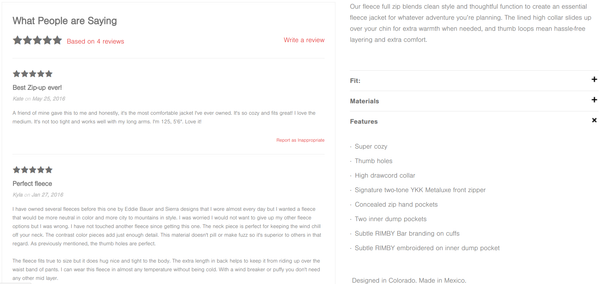
“We showcase an array of different images and blog posts about the products and the products being used,” says Rosenthal. She explains that showcasing the product in a way it’s actually going to be used helps customers understand how the product works and envision themselves in their own well-equipped and -dressed outdoor adventures.
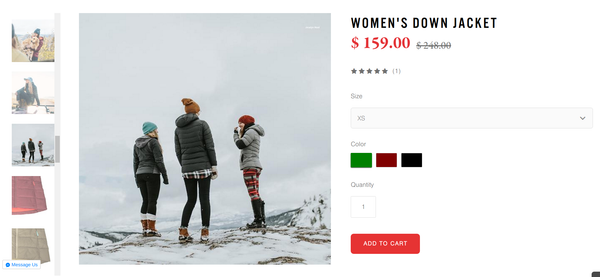
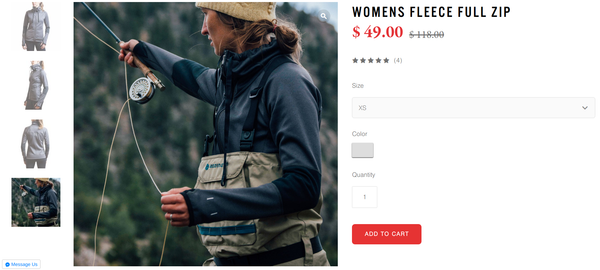
Rosenthal says the brand also prides itself on quick customer service via email, phone and social media — and this could be the ultimate factor in Mountain Standard’s triple-threat approach to creating great customer experiences online.
Getting feedback from customers and making it easy to evaluate products and make purchasing decisions online is critical. But it would all fall flat if no one was available to respond to customer needs when they’re expressed.
“We answer emails and messages as fast as we can,” Rosenthal shares. She explains that the company also replaces products with manufacturer’s defects immediately and at no additional cost to the customer.
“Content, Content, Content!”
That’s exactly what Rosenthal exclaims when asked what contributes to the company’s overall success. “Quality content and a great brand story is going to bring the customers,” she explains.
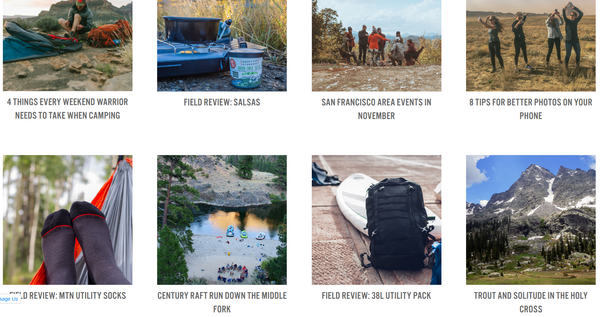 Mountain Standard creates content both on its own site and on social media. Their blog, RIMBY Tales, provides advice, tips, reviews, and stories of outdoor adventures. Throughout the posts you can find featured products and images to illustrate the content.
Mountain Standard creates content both on its own site and on social media. Their blog, RIMBY Tales, provides advice, tips, reviews, and stories of outdoor adventures. Throughout the posts you can find featured products and images to illustrate the content.
Outside of their own website, the brand keeps a number of social media profiles. Given the high-quality products and equally high-quality photographs of them, they seem to have the most traction and largest following on Instagram.
“Posting amazing content on social media helps us greatly,” shares Rosenthal. “It’s our images that people are able to connect with on a personal level.”
It’s not hard to see why. Mountain Standard curates wonderful, inspiring images for the outdoor enthusiast. They stay relevant, too, by featuring shots that change to reflect the actual season outside. As a quick aside, if you're looking to upgrade your product shots try these t-shirt mockups and templates.
They use the platform to address customer service issues and problems, as well. When less-than-pleased customers leave unhappy comments on photos, the brand tackles them head on and doesn’t shy away from publicly resolving the problem.
Doing so helps accomplish a few things. For one, that customer received a personal and prompt response despite their negative comment. Other potential customers can see how quickly, professionally, and courteously even “bad” customer reviews are handled, and how Mountain Standard does their best to take care of the problem.
Mountain Standard remains responsive across other social media platforms, including Facebook. They make themselves available through Facebook Messenger and encourage consumers to chat with them there.
It’s a smart strategy, since so many customers already maintain a daily Facebook habit. Consumers don’t need to take additional steps to get in touch with the company. They get to talk with Mountain Standard where they already are, which makes customer service easy and convenient for the people it’s actually supposed to serve.
In addition to using Facebook as a customer service channel, they share features on other sites alongside similar content to what is posted on Instagram.
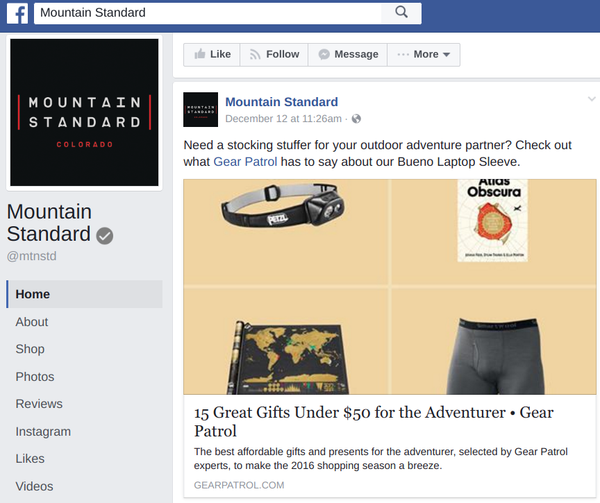
The company gives its social content a boost with paid ads. Rosenthal says they invest in Facebook Advertising and believe it’s helped expand their reach and increase sales. Outside of social, they send weekly email campaigns to stay in touch with potential and current customers.
Other Lessons Learned from Mountain Standard’s Success
In addition to killer customer service (“Kill the customer with kindness,” says Rosenthal) which includes making it easy to shop and purchase online, Mountain Standard sets itself apart in a few other ways that other retailers can learn from.
Find Your Own Vibe
The company says their dedication to the #RIMBY vibe helps set them apart from other retailers. The acronym stands for “right in my backyard,” and aims to celebrate people, places, adventures, and landscapes of the MST region where Colorado lies.
“We feel like there’s no need to spend money on a huge epic adventure when there’s so much to do RIMBY,” Rosenthal explains.
Developing their own unique feel makes Mountain Standard stand out as a brand. It also helps potential buyers who resonate with the message feel like the company and its products understands them better than a larger, faceless (or vibe-less) corporation who doesn’t cater to the region and its nuances.
Other retailers can do the same by identifying a feel or mood they want to set and create -- and share with the people who shop with them. What do you want to evoke in your customer when they think of your brand? How can you “get” them in a way other companies just don’t?
Invest in Online Marketing
Creating great content is only the first step for your online marketing efforts. Smart marketers will tell you 20% of your resources should go into creating the content. The other 80%? Use it to promote that content.
“Spend money on online advertising, with Facebook, Adwords, and a SEO strategy,” advises Rosenthal. By investing this way, you reach people where they already are. Social media is also a great way to create one-on-one, personal connections with the people you want as customers.
Of course, if you put your money into marketing, you need to know what works and what doesn’t. This doesn’t mean rely on what you think works and doesn’t. Look at the numbers and know.
“Make sure all of your tracking is set up correctly in Google Analytics,” Rosenthal suggests. “This way, you can truly track how you’re doing with your advertising efforts and constantly be adjusting based on real data.”
Listen
Connections with customers are good. Creating a relationship where they feel heard? Even better.
“Always be evolving based on customer feedback,” says Rosenthal. Mountain Standard does this by listening to their customers — whether it’s through social media comments, live chat, product reviews, or survey responses.
Give customers a chance to express their thoughts and opinions. Then develop a system to ensure you hear them when they speak up.
The Future of Premium Goods at an Honest Price
What’s next for the outdoor retailer focused on helping people spend less on gear so they can spend more on their actual adventure? Not more stores — at least not for now.
They’ll continue cutting their own costs and overhead so customers can enjoy steeply discounted products. That also allows Mountain Standard to invest in the products themselves.
“We plan on expanding our product line into a few new categories to see how people react to it,” shares Rosenthal. “We can launch a limited edition product, see how it does, and evaluate its performance with customers before moving forward. That’s the beauty of an online business.”
Read more
- From Sticky Notes to Shopify POS: How a Funeral Symbolized New Life at Dollhouse Junction
- Nalata Nalata Team Brings High Value Abandoned Carts Into Their Store
- How Ryzon Increased Store Conversion Rates by Over 40% with Shopify POS
- Despite Full-time Jobs, These Two Entrepreneurs Ran a Successful Pop-up Shop for Their Online Store
- How Summer Solace Tallow Switched to Shopify POS to Unify its Sales Channels
- How Wine Central Uses Shopify POS to Improve Product Recommendations and Lift In-Store Sales
- MAAP Rides to Customer Success with Shopify POS
- How Florentine Kitchen Knives Sped Up Store Checkout by 50% with Shopify
- How Oliviers & Co. Grew Revenue 350% by Unifying Online and In-Person Selling





